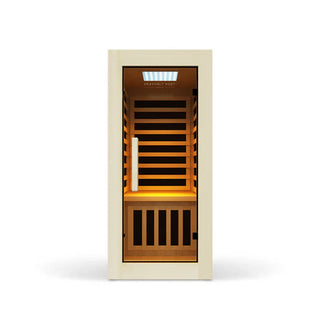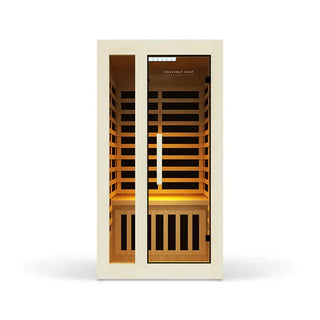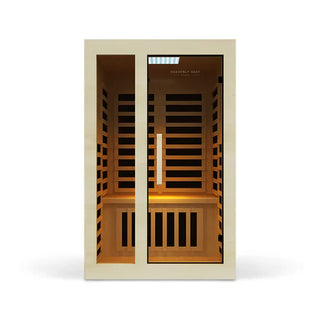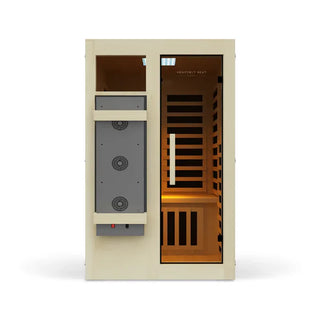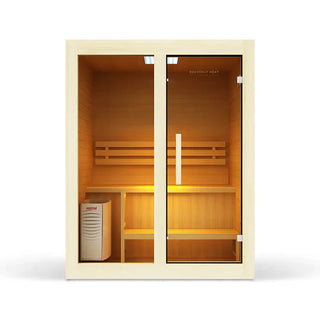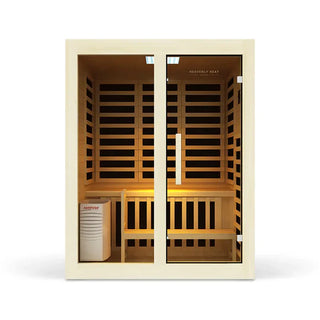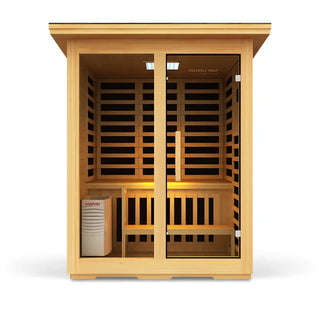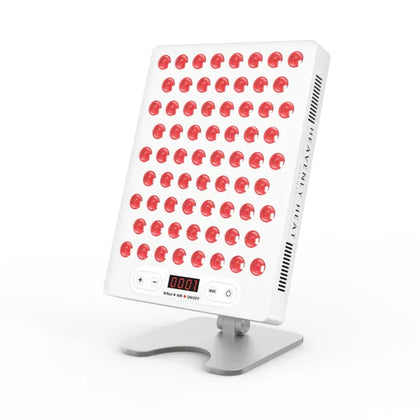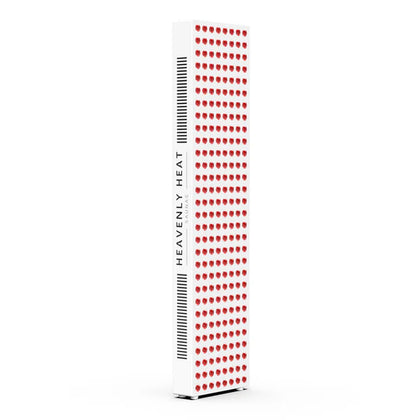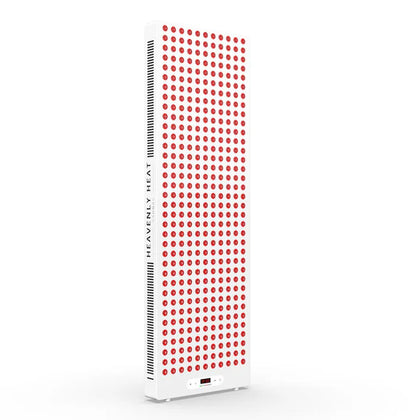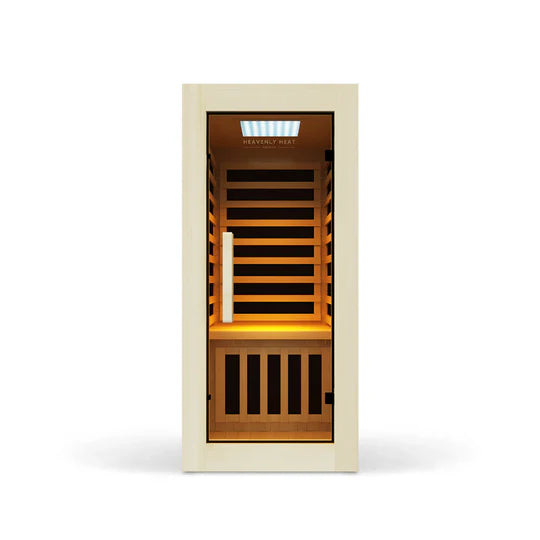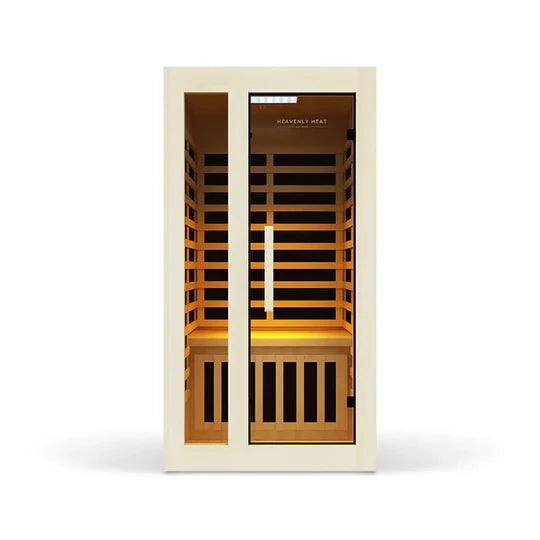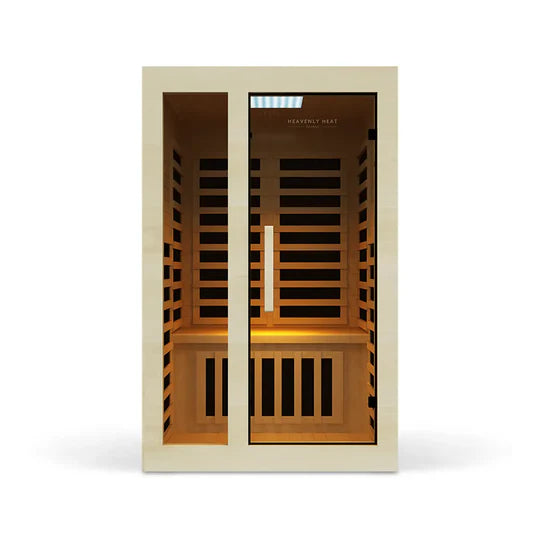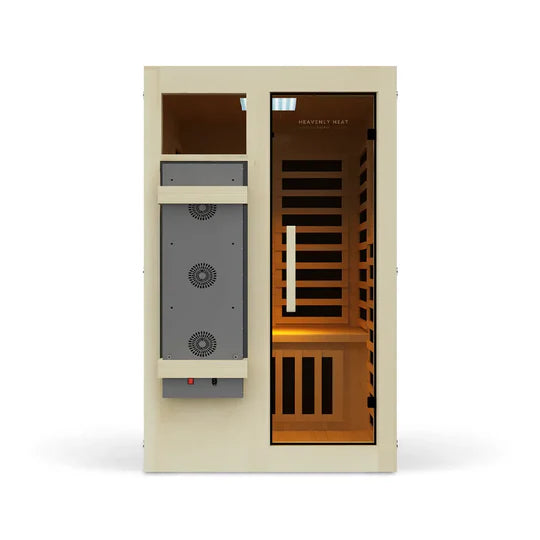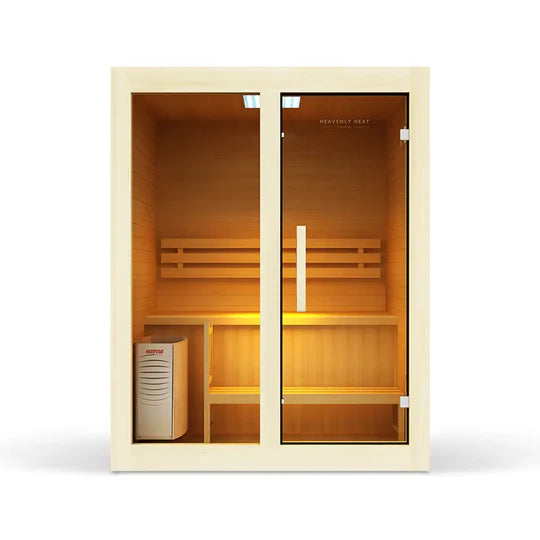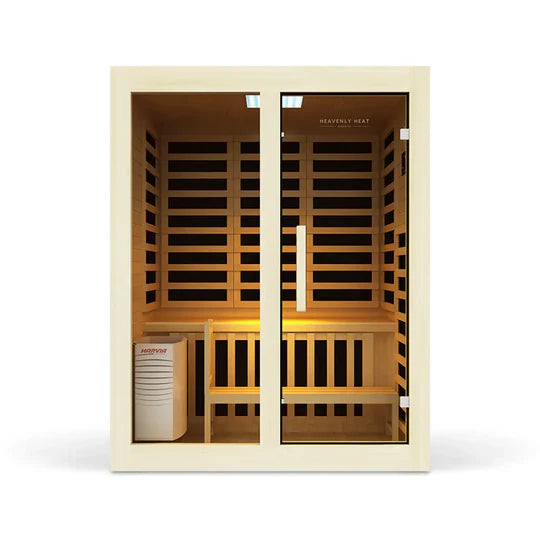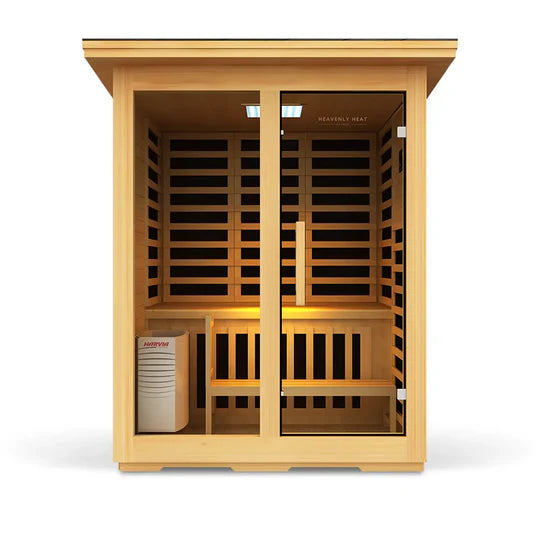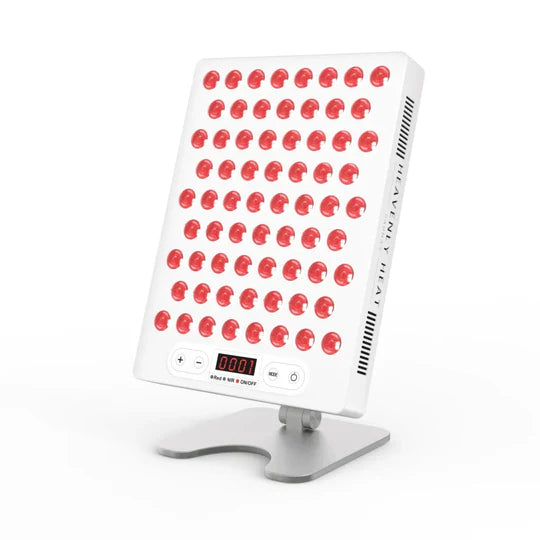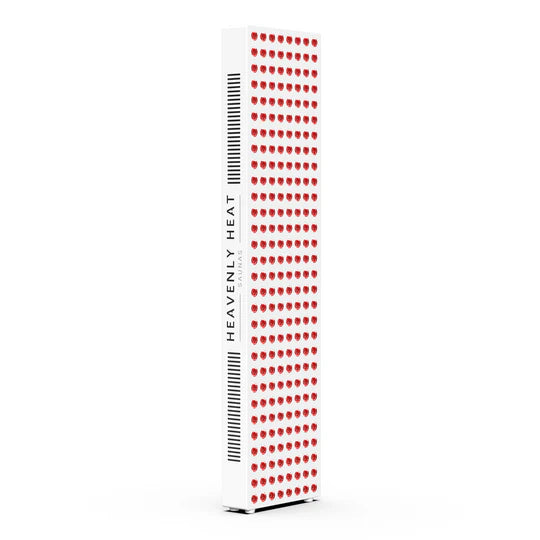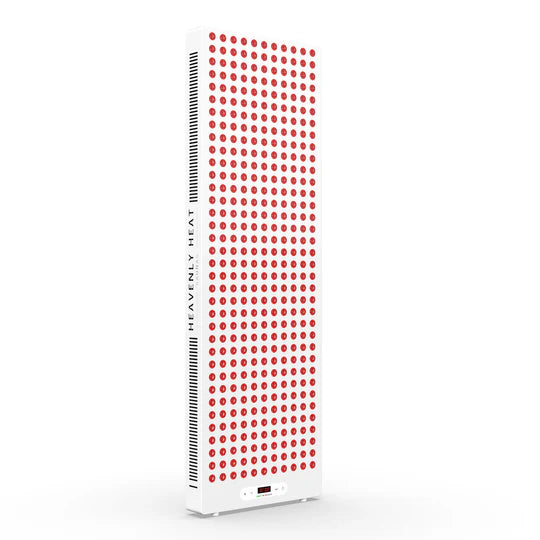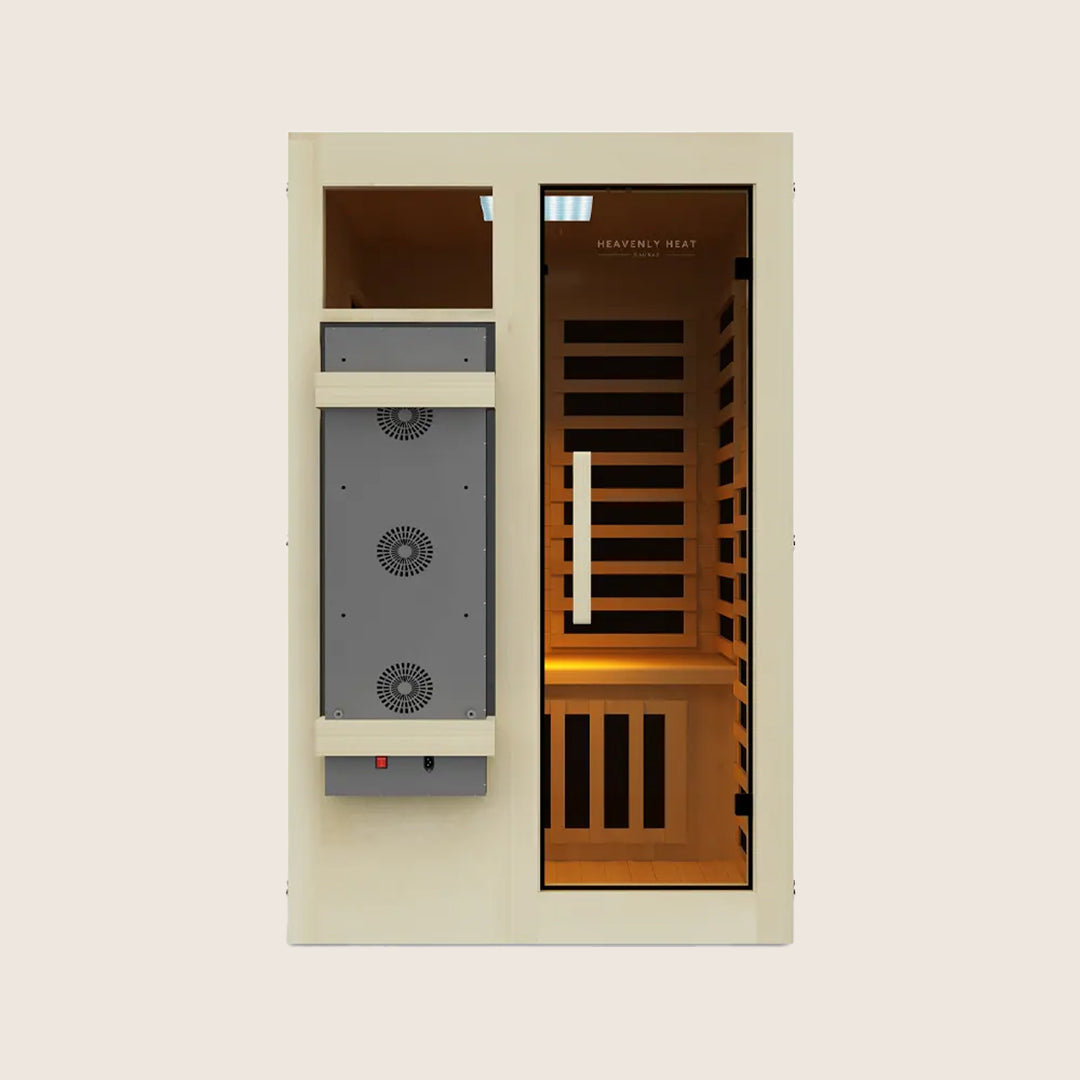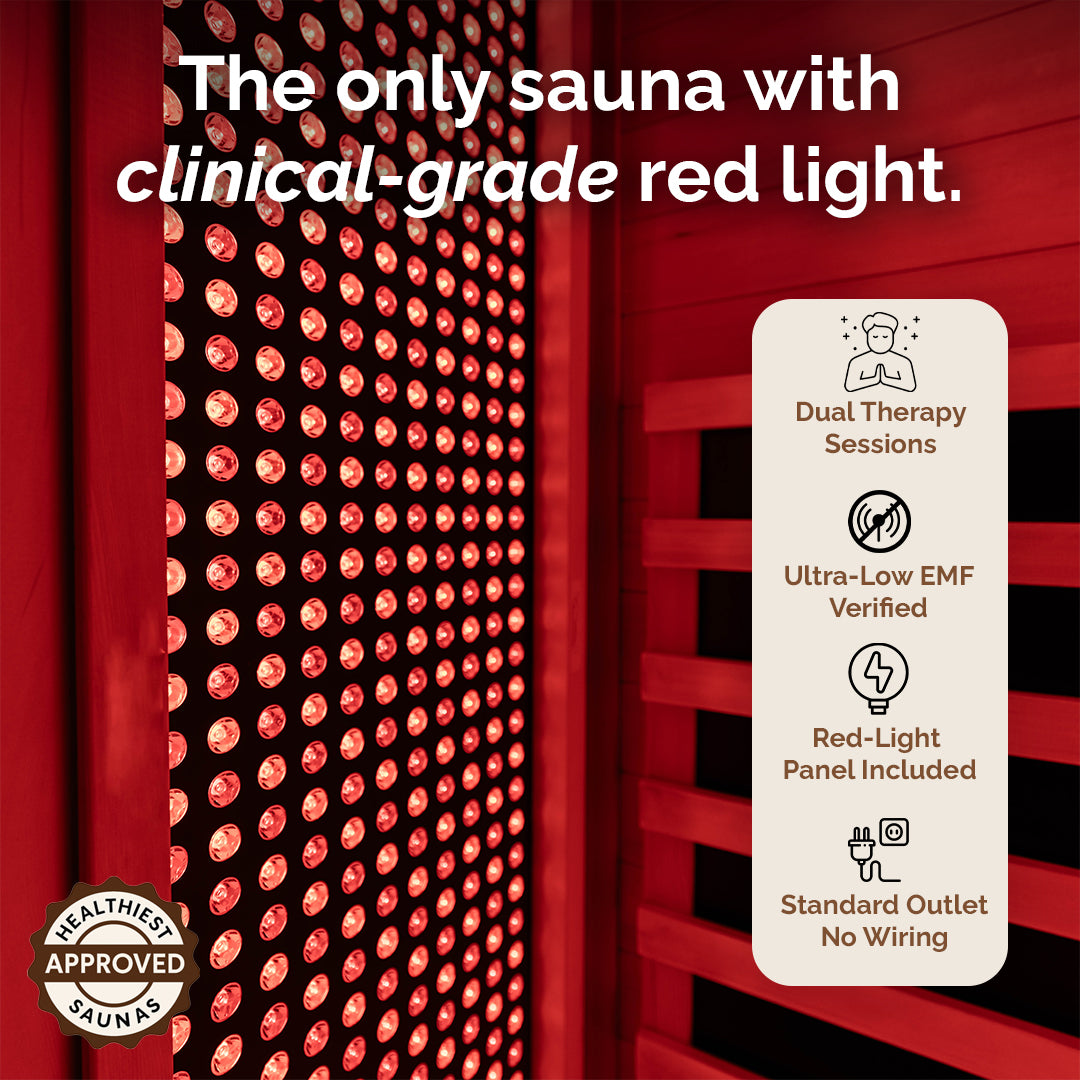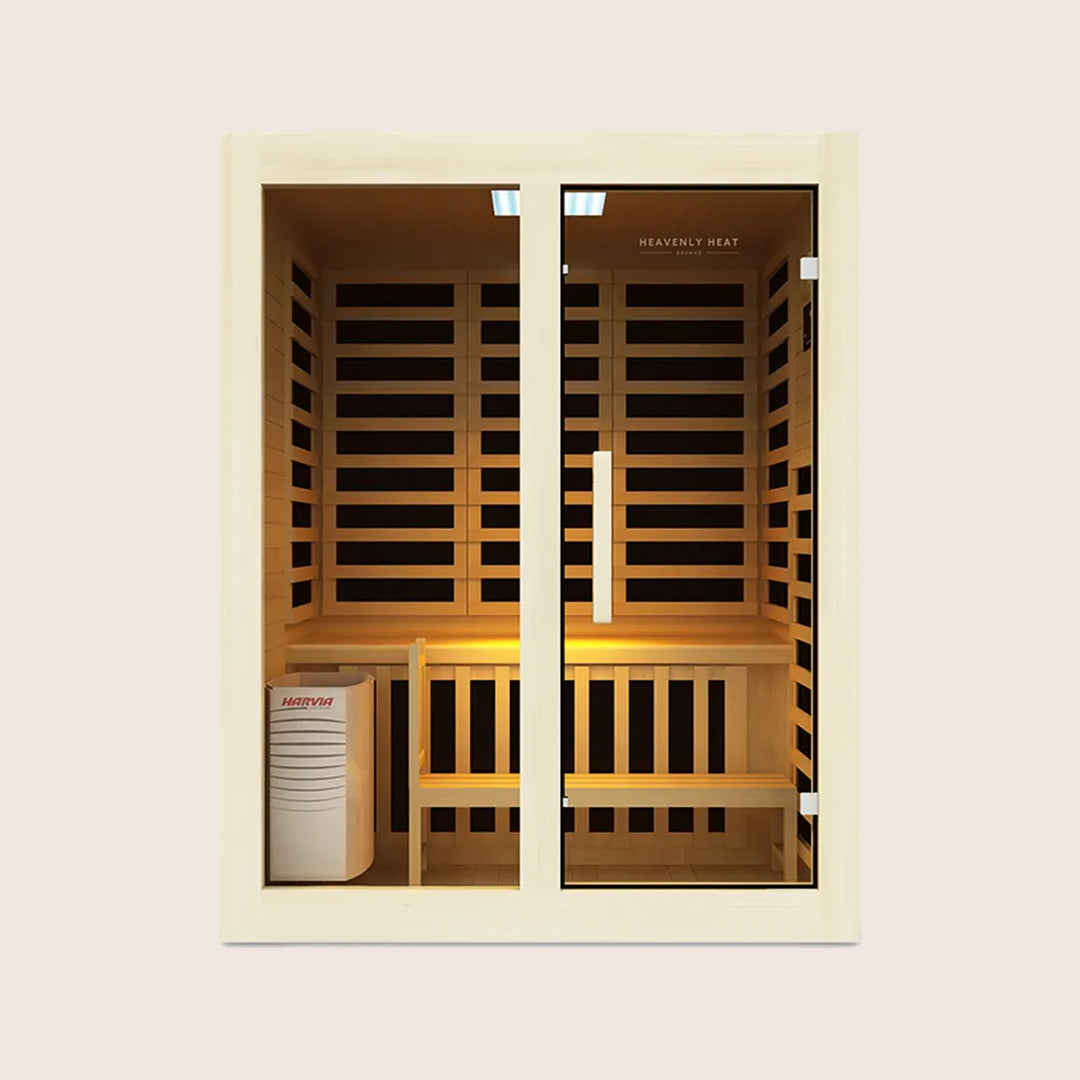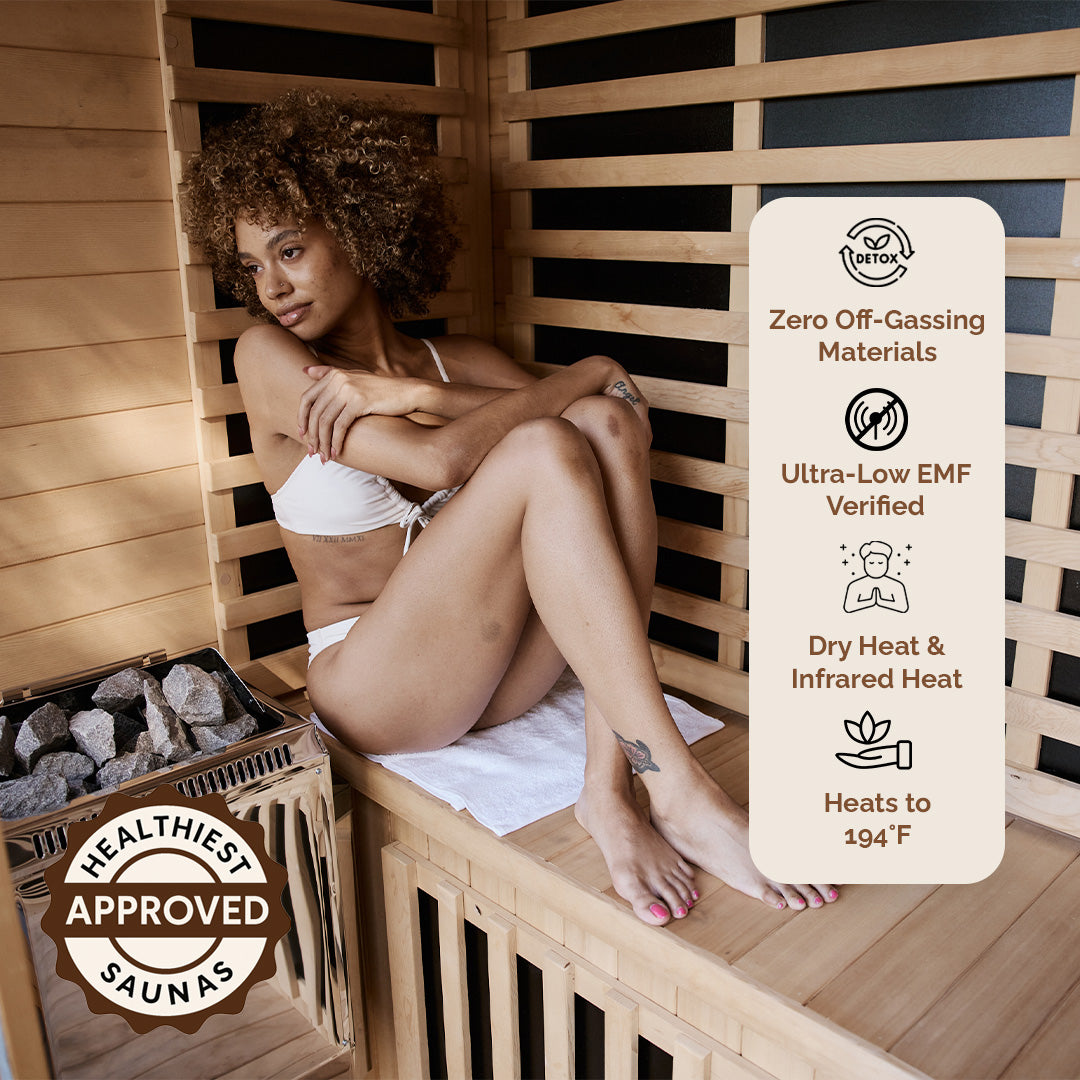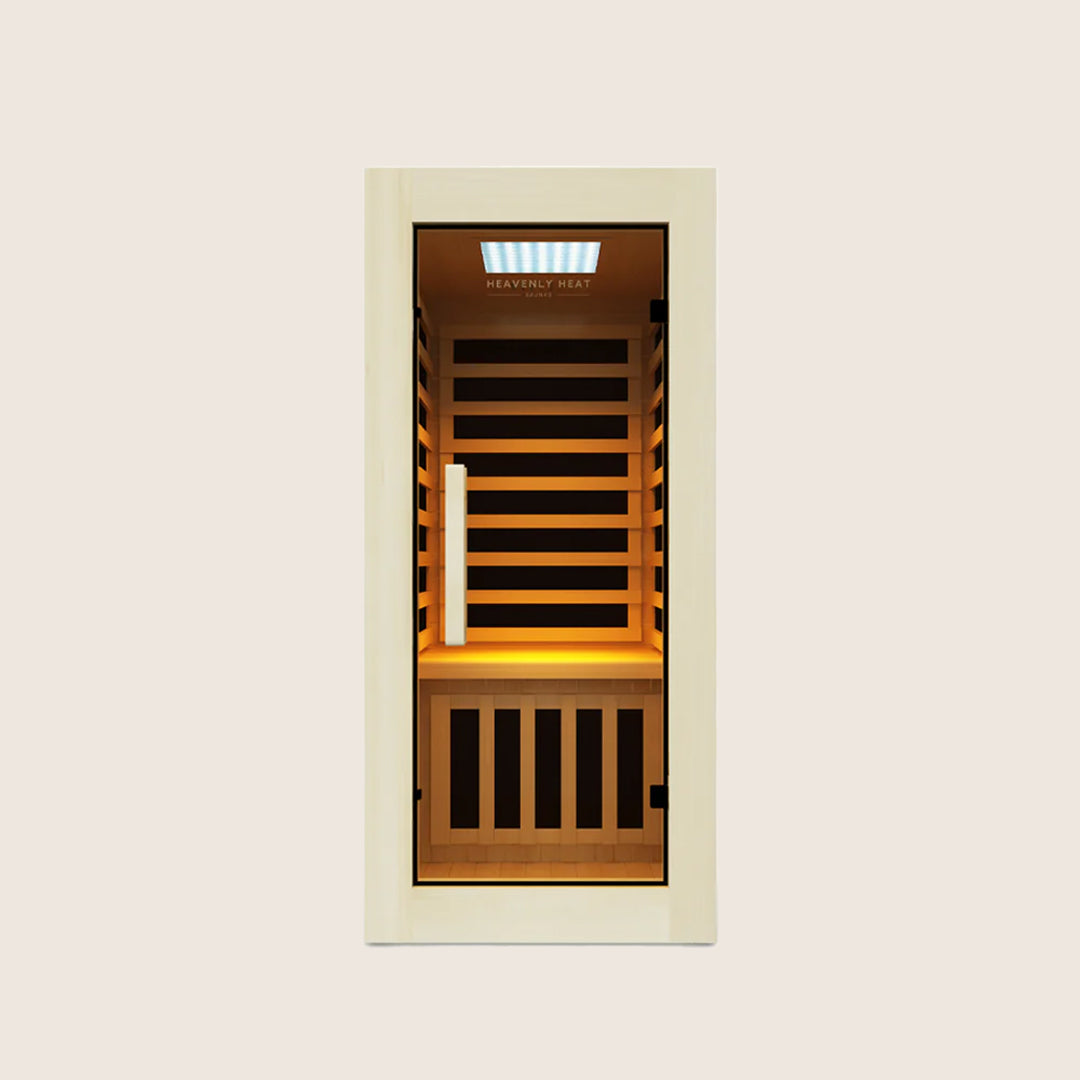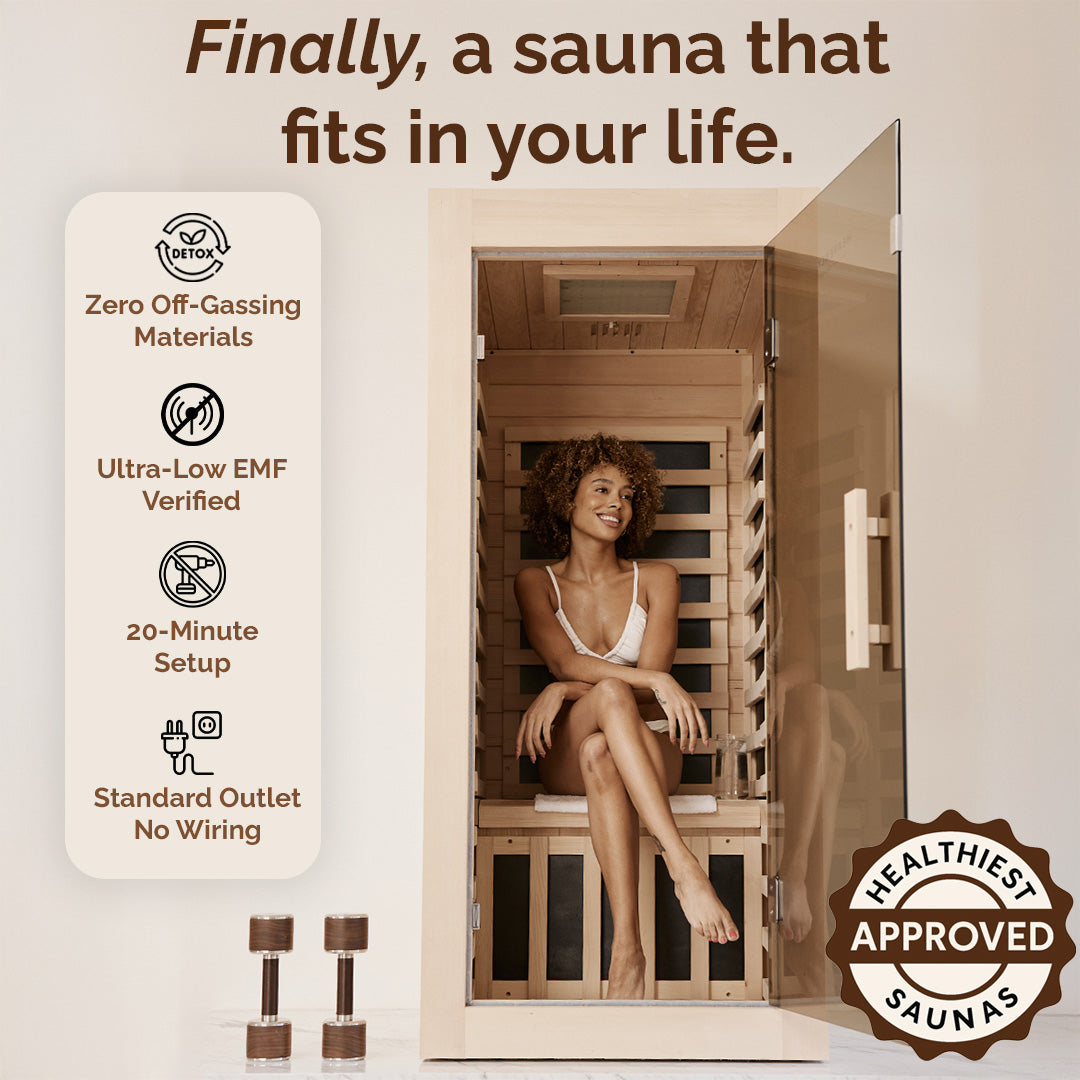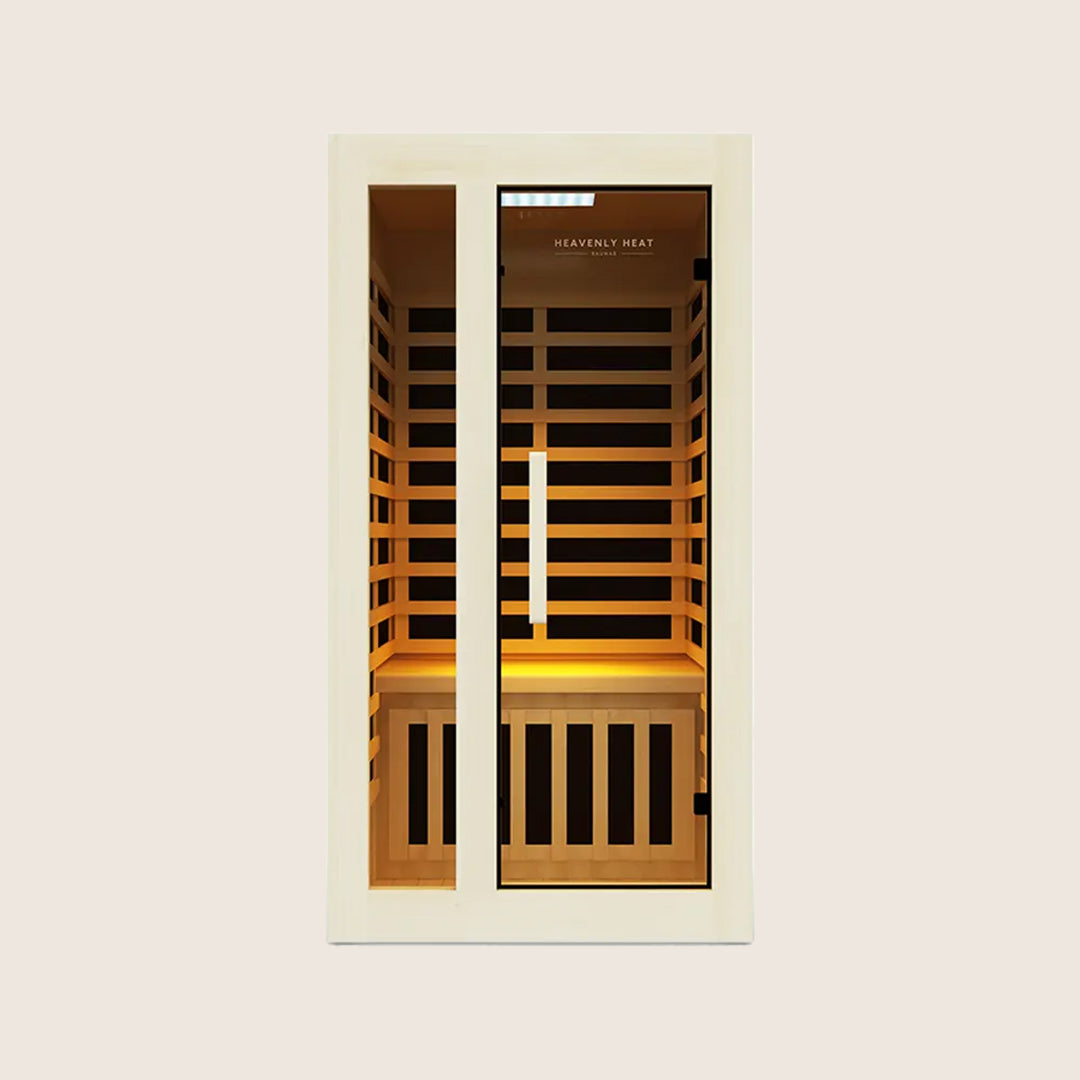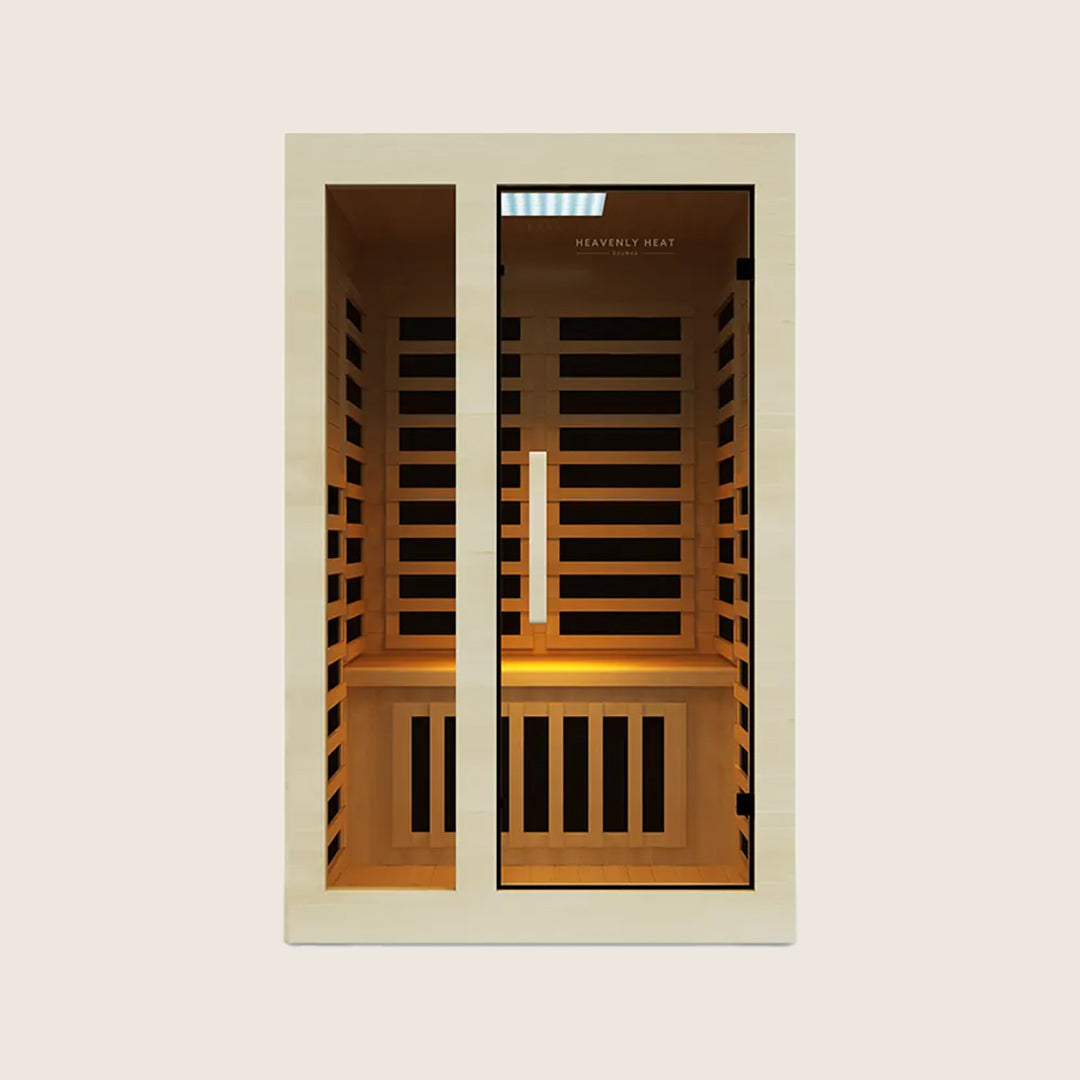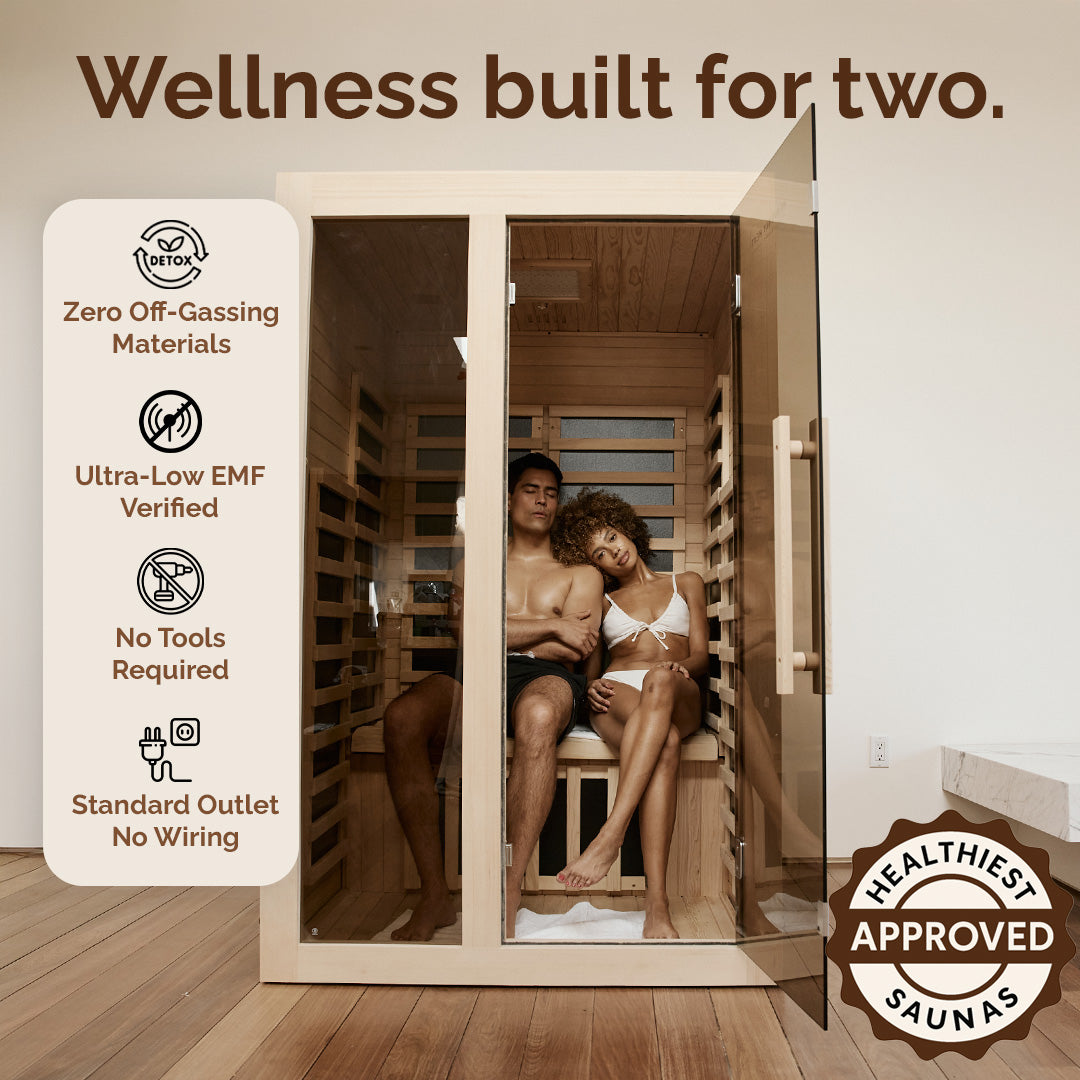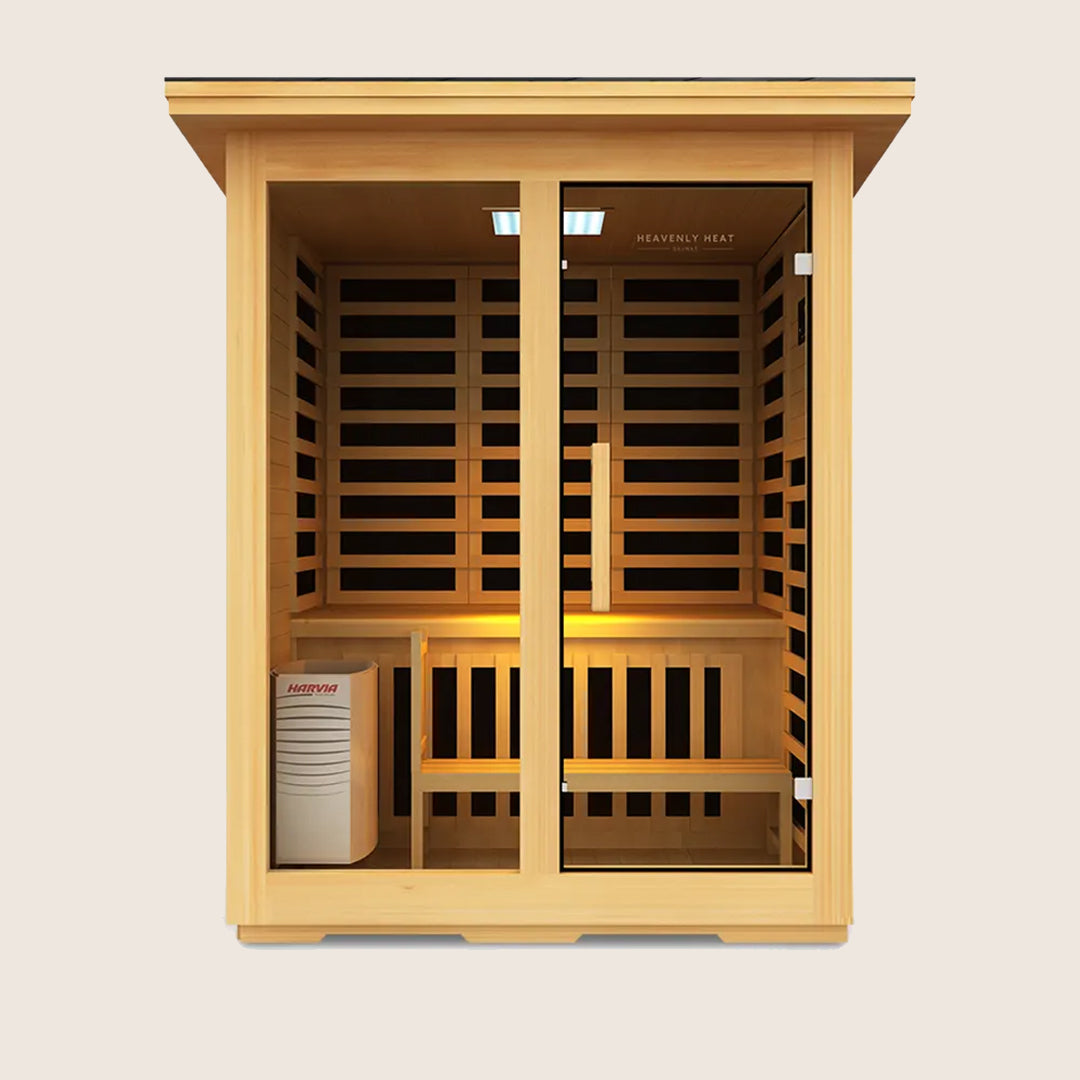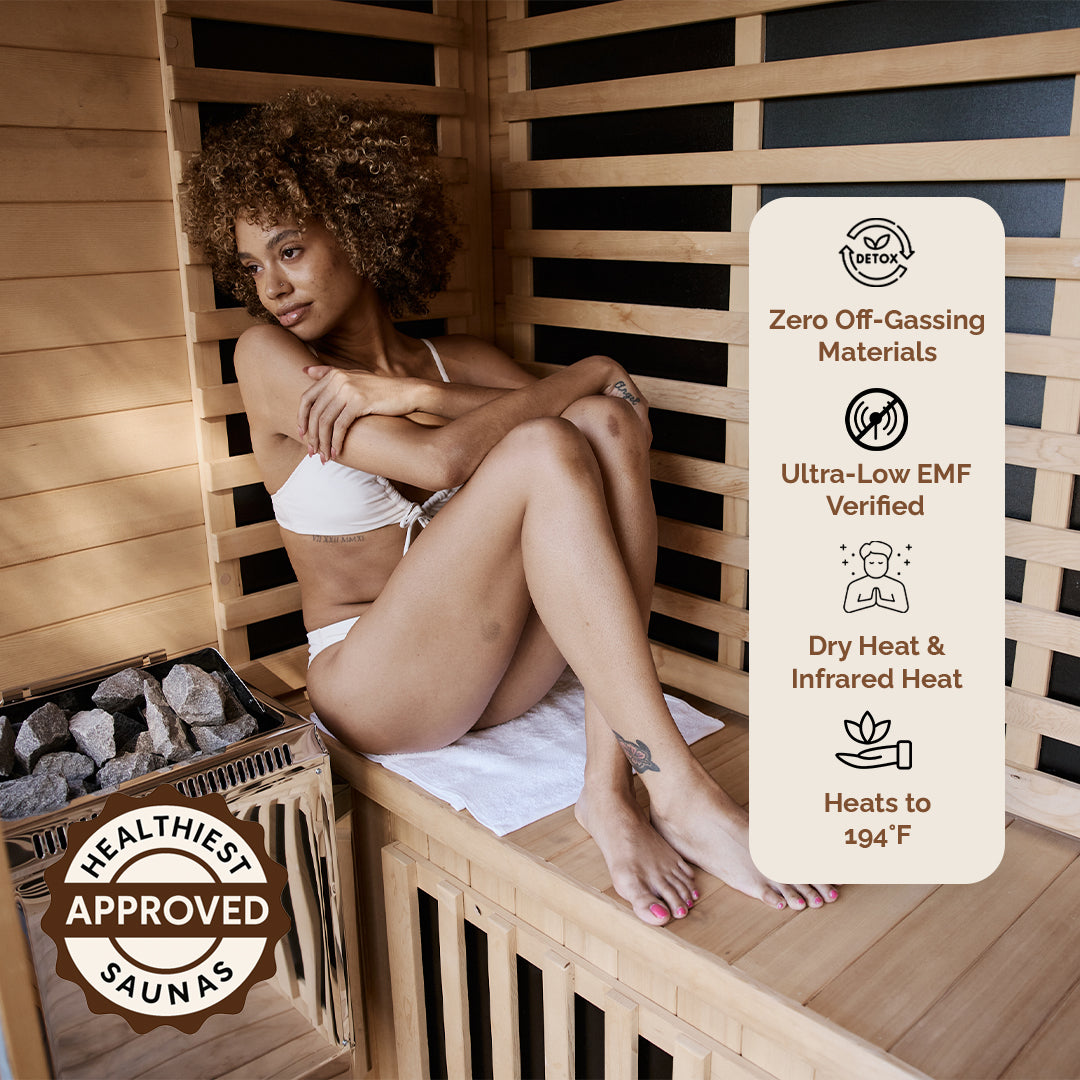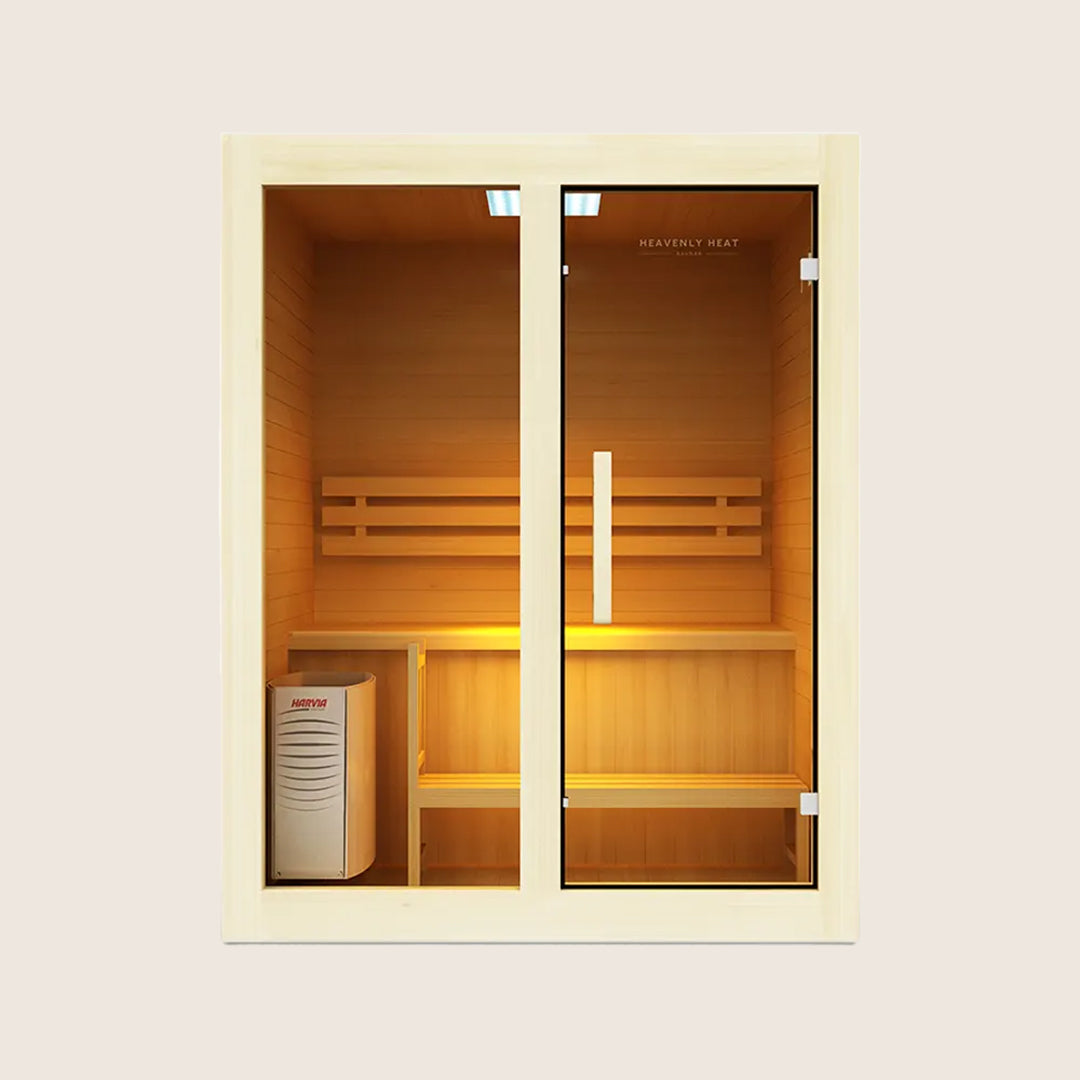How Hot are Saunas and What Temperature Should a Sauna Be?

For centuries, people have used heat therapy to help them relax, undergo detoxification, relieve muscle pain, and improve sleep.
If you’re a new sauna owner or going for the first time in a public sauna, you may not know what temperature your sauna should be.
In this article, we will explore the different sauna temperatures and discuss the ideal temperature range for a sauna.
Table of contents
Key Takeaways
-
Choosing the right sauna temperature is crucial to maximizing benefits while avoiding overheating and dehydration.
-
Infrared saunas operate at lower temperatures (120-140°F), while traditional saunas can reach up to 200°F.
-
Steam saunas provide high humidity with temperatures ranging from 100-120°F, offering respiratory benefits.
-
Safe sauna use depends on age, health conditions, and individual tolerance, with lower temperatures recommended for children, pregnant women, and older adults.
-
Staying hydrated, cooling down after a session, and adjusting the temperature to personal comfort are keys to a safe and enjoyable sauna experience.
Why is sauna temperature important?
- Temperature Determines Sauna Benefits: To fully enjoy sauna benefits, choosing the right temperature is essential. Too low, and the benefits are limited; too high, and risks like overheating arise.
- Typical Sauna Temperature Ranges and Their Effects: Traditional Finnish saunas heat between 150°F and 195°F (65°C to 90°C), promoting deep sweating and detoxification. Infrared saunas use gentler heat from 120°F to 150°F (49°C to 65°C), aiding muscle relaxation and recovery.
- Risks of Excessive Sauna Heat: High sauna temperatures can cause dehydration, overheating, and in extreme cases, heatstroke, highlighting the need for moderation.
- Expert Insights on Sauna Health Benefits: Dr. Victoria Maizes emphasizes saunas reduce stress, detoxify, and improve heart health by boosting circulation and promoting relaxation.
- How Heat Therapy Works on the Body: Rising sauna temperatures raise skin temperature to around 40°C (104°F), triggering heavy sweating and increased heart rate as the body cools itself.
- Finding the Right Sauna Temperature Balance: Choosing the right temperature ensures the body relaxes and heals safely, avoiding dehydration and overheating while maximizing benefits.
Key Takeaways:
Ideal sauna temperature is crucial for safety and effectiveness
Traditional Finnish saunas: 150°F–195°F (65°C–90°C)
Infrared saunas: 120°F–150°F (49°C–65°C)
Too high = risk of overheating, dehydration, or heatstroke
Proper temperature boosts circulation, relaxation, detox, and skin health
Choose a temperature that’s comfortable and safe for your body
How hot should a sauna be for effective detoxing?
For effective detoxing, saunas should be hot enough to make you sweat but still feel comfortable. Infrared saunas are gentler, while traditional ones are hotter for a deeper cleanse.
For optimal benefits, aim for sessions of 15-30 minutes, depending on your heat tolerance and sauna type. Drink plenty of water, and don’t stay in too long to avoid feeling dizzy.

How hot can a sauna get?
Infrared sauna
- Infrared saunas stay warm but not too hot: Infrared saunas work at a comfortable temperature between 120˚F and 140˚F, making them easier to enjoy for people who don’t like very hot heat.
- Infrared heat warms your body gently through the skin: They use special heaters that send heat directly to your skin, so you feel warm without the air getting too hot.
- Infrared saunas help with health and muscle recovery: These saunas can help with skin and breathing problems and also reduce muscle soreness by improving blood flow.
- Traditional saunas get much hotter than infrared ones: Dry saunas can heat up to 200°F by warming rocks, creating a very hot environment that makes you sweat a lot.
- Wood fires make traditional saunas feel natural and warm: Saunas heated with wood create a cozy feeling and need you to control the temperature yourself.
- Adding water to hot stones makes traditional saunas feel steamier: Pouring water on the heated stones raises the humidity, making the sauna feel hotter, but only if the stones are really hot.
- Beginners should start slow in traditional saunas and drink water: New users should start with short sessions of 5–10 minutes and slowly increase time while drinking water and watching out for feeling too hot.

Steam sauna
- Steam saunas stay warm but not too hot: Steam saunas, also called steam rooms, usually keep the temperature between 100°F and 120°F (38°C to 49°C).
- Steam is made by adding water to hot rocks or using a steam machine: The steam in these saunas comes from pouring water over hot rocks or using a steam generator to create moist heat.
- Steam saunas have lots of moisture that helps your skin and blood flow: Because of the high humidity, steam saunas open your pores, improve blood circulation, and hydrate your skin better than dry saunas.
- Steam helps with breathing but watch out if you have asthma: Warm, moist air in steam saunas can help clear mucus and ease breathing for some people, but heat may make asthma worse for others, so be careful.
- Japanese baths and onsen use warm water instead of steam for relaxation: Japanese sentō and onsen are like steam saunas but focus on soaking in warm, mineral-rich water to relax muscles and help the body recover.
Maximum Temperature Limits of Different Saunas
- Finnish Saunas Can Get as Hot as 195°F (90°C): Finnish saunas reach very high temperatures up to 195°F (90°C), but most people like it a bit cooler between 150–175°F (65–80°C).
- Russian Banyas Are Hotter and More Humid, Up to 200°F (93°C): Russian banyas combine strong heat with humidity around 40–60%, making them hotter and steamier than dry saunas.
- Venik and Whisk Massages Help With Detox in Russian Banyas: Using leafy bundles called venik and whisk massages in banyas helps spread steam and improve circulation for detox benefits.
- Steam Saunas Stay Cooler but Feel Hot Because of Humidity: Steam rooms usually have lower temperatures, around 110–120°F (43–49°C), but feel hotter because of the moist air.
- Electric and Public Saunas Have Safety Limits Around 190°F (88–90°C): Electric saunas at home are capped near 194°F (90°C), and public saunas keep temperatures under 190°F (88°C) to keep users safe and comfortable.

Why Saunas Feel Hotter at the Same Temperature
- Heat Feels Stronger Because Sauna Air Stays Trapped: In a sauna, heat doesn’t spread out like in a normal room, so the air feels thick and hotter on your skin.
- Steam Makes Sauna Heat Feel More Intense: Adding water to hot rocks creates steam, which makes the air heavier and the heat harder to handle.
- Infrared Saunas Heat Your Body, Not the Air: These saunas warm your body directly, so you feel the heat differently than in a regular sauna.
- Less Air Movement Makes the Heat Stick Around: When the air doesn’t move much, the heat stays close to you, making the sauna feel hotter.
- Your Body Works Harder to Cool Off, So Heat Feels Stronger: Because of the hot air and steam, your body tries extra hard to stay cool, which makes the heat feel even more intense.

Summary
Saunas can get extremely hot, with different types offering varying temperature ranges. Infrared saunas are gentler, while traditional dry and steam saunas can reach intense heat. Knowing your limits and staying hydrated is key for a safe and enjoyable sauna experience.
Determining the Ideal Temperature Range for Sauna
- Finding the right heat helps your body get sauna benefits safely: You need to balance getting the heat benefits while making sure it’s not too hot for your body.
- The ideal temperature feels comfortable and works well: The best sauna heat is where you feel good and get the health benefits without feeling too hot or unsafe.
- Most people like 150-175°F for regular saunas and 120-130°F for infrared saunas: These temperature ranges are popular and comfortable for different types of saunas.
- Beginners should start cooler and slowly heat up to find what feels best: Start around 120-140°F and increase the heat little by little to find your comfort zone.
- Experts use high heat with some humidity to get the most out of saunas: Dr. Rhonda Patrick uses about 174°F and 10-20% humidity, adjusting heat based on her workout and comfort.
- Very hot saunas are not good for people new to using them: High temperatures like 174°F can be too strong for beginners and might be uncomfortable or risky.
- Your body tells you when the heat is too much: It’s important to listen to your body and avoid pushing yourself if you can’t tolerate a high temperature. Your body will signal when it’s time to exit or cool down, and it’s crucial to respect those signals to avoid discomfort or health risks.
- Lower the temperature or time if you feel uncomfortable: If the heat feels overwhelming, reduce the temperature or shorten your sauna session to stay comfortable and safe.
- The right sauna temperature should feel relaxing, not unbearable: Sauna temperatures in this range are hot enough to relax your body but not so hot that you feel uncomfortable or risk overheating or dehydration.
- Everyone’s ideal sauna temperature is different: Sauna settings depend on your heat tolerance, health, age, and why you are using the sauna.
- Cooling down after sauna helps your body relax: Taking a cool shower or resting in a cool room after your sauna session helps balance your body temperature and improves relaxation.
Quick Summary:
Traditional Sauna: 150–175°F (65–80°C)
Infrared Sauna: 120–130°F (49–54°C)
Beginners: Start at 120–140°F and increase gradually
Expert Tip: Dr. Rhonda Patrick uses 174°F with 10–20% humidity
Listen to Your Body: Exit or cool down if it feels too hot
Aftercare: Cool shower or rest helps regulate temperature
Safe Sauna Temperature
It is important to stay safe while relaxing in the sauna. The Finnish Sauna Society advises never to exceed 212 degrees Fahrenheit (100 degrees Celsius) in your sauna, as a temperature of 100 degrees Celsius or higher can potentially lead to heat exhaustion, dehydration, and other heat-related illnesses.
Remember that your age and health are important factors in setting the temperature. Here are a few factors to consider:
For kids
- Safe Sauna Temperature for Kids: If kids will be using the sauna, keep the temperature around 105 to 130 degrees Fahrenheit or lower to prevent overheating.
- Kids Are More Sensitive to Heat: Children can’t handle heat as well as adults. Extreme heat exposure can cause serious health risks such as muscle breakdown, kidney failure, seizures, coma, or even death .
- Short Sauna Sessions with Close Supervision: Sauna time for kids should be limited to 15 minutes max per session. Children aged 6 and above must be supervised closely to ensure they’re comfortable and safe.
- Always Stay Nearby and Monitor Well-being: An adult should always be nearby during the sauna session to watch for any signs of discomfort or distress and to keep the child safe.
For Those with Health Conditions
- People with health issues must check with their doctor first: If you have heart problems or other health conditions, talk to your doctor before using a sauna. They may tell you to avoid it or suggest a lower temperature and shorter time.
- Keep sauna sessions short and the heat gentle: Don’t stay in the sauna longer than 20 minutes, keep the temperature low, and take breaks to cool down and drink water.
- Avoid sudden cold water if you have heart problems: Jumping into cold water after a sauna can be dangerous for people with heart conditions because it may cause heart issues.
- Drink water and stop if you feel unwell: Drink water and eat a light snack before using the sauna. If you feel dizzy, have chest pain, or your heart beats fast, leave the sauna right away.
Heart Disease (e.g. heart failure, arrhythmias) |
Uncontrolled High Blood Pressure (Hypertension) |
Low Blood Pressure (Hypotension) |
Pregnancy (especially high-risk pregnancies) |
Kidney Disease |
Epilepsy or Seizure Disorders |
Respiratory Conditions (e.g. asthma, COPD) |
Active Infections or Fever |
Skin Conditions (e.g. eczema, psoriasis flare-ups, open wounds) |
Recent Surgery or Open Wounds |
Severe Dehydration or Electrolyte Imbalance |
When pregnant
- Being in a hot sauna can be risky during pregnancy: High heat can lead to dizziness, dehydration, and overheating, which can affect both you and your baby. It’s important to be careful with your body in a sauna while pregnant.
- Early pregnancy is not the right time for sauna use: The first trimester is when your baby is still developing. Using a sauna during this time might increase risks, so it’s often safest to avoid it altogether.
- Short sauna sessions are safer for pregnant women: Keep sauna time under 10 minutes and make sure the temperature doesn’t go over 104°F (40°C). Staying in too long or letting it get too hot can be harmful.
- Saunas should be avoided in the last weeks of pregnancy: In the third trimester, especially 4 to 6 weeks before your due date, it’s best to stop using saunas to avoid unnecessary stress on your body and your baby’s.
- If something feels wrong, leave the sauna right away: If you start feeling lightheaded, nauseous, or too hot, it’s a sign to leave immediately. Always trust how your body feels.
- Talk to your doctor before using a sauna when pregnant: Every pregnancy is different, so it's a good idea to ask your doctor before using a sauna. This helps keep both you and your baby safe.
Recognizing When the Heat is Too Much
- Feeling dizzy means the sauna is too hot for you: When the heat gets unsafe, your body lets you know. Dizziness or lightheadedness is a serious sign that your body isn’t handling the temperature well.
- Nausea is a clear warning your body is overheating: If you start to feel sick while in the sauna, it’s your body’s way of saying the temperature is too much.
- If you feel faint, it’s time to step out immediately: Feeling faint is your body shouting for help. Get out, cool down, and rehydrate right away.
- Too much heat can make you sweat a lot and feel weak: When your body is overheating, you may sweat excessively, feel confused, or become very tired, this is heat exhaustion.
- Being dehydrated makes it harder for your body to handle heat: Without enough water in your system, your body can’t manage the sauna’s heat properly. Dehydration makes all symptoms worse.
- Drinking water and listening to your body keeps you safe: To avoid trouble, drink water before and after your sauna session, and always leave if your body feels overwhelmed.
Adjusting Sessions Based on Personal Tolerance
- It’s best to start with lower heat and shorter sessions: When you're new to the sauna or unsure of your limits, begin with a moderate temperature like 150°F (65°C) and keep your sessions short. This helps your body ease into the heat safely.
- If you feel dizzy or sick, it's time to step out: Your body will tell you when it’s had enough. Feelings like dizziness, nausea, or too much sweating are signs to take a break immediately.
- Your body can handle more over time, but don’t rush it: As you use the sauna regularly, you can slowly raise the temperature or extend your time inside. But pushing too fast can lead to overheating, so be patient.
- Everyone reacts to heat differently, so go at your own pace: Don’t compare your session to someone else’s. Your heat tolerance is personal, so adjust your settings based on how you feel, not on what others are doing.
- Drinking water helps your body manage the heat: Staying hydrated before and after your sauna session makes a big difference. It supports your body in dealing with the temperature and helps you feel better afterward.
- Building heat tolerance takes time and care: If you want to handle more heat or stay in longer, do it slowly. Taking your time is the safest way to improve without hurting yourself.
| Group | Recommended Temperature | Notes |
| Children | 105-130°F | Keep sessions short, supervise closely |
| Pregnant Women | ≤104°F (40°C) | Avoid overheating, consult a doctor |
| Adults | 150-175°F (traditional) / 120-130°F (infrared) | Adjust based on comfort and tolerance |
| Elderly | 110-140°F | Stay hydrated, limit duration |
| People with Health Conditions | Lower temperatures (as advised by a doctor) | Always consult a healthcare professional |
Summary
Always listen to your body in the sauna. Keep temperatures safe, sessions short, and stay hydrated. Adjust based on your health, age, or pregnancy. If you feel dizzy or unwell, leave immediately. Your comfort and safety matter most for a good experience.
How can you measure the temperature in a sauna accurately?
- Thermometers made for saunas give the most accurate results: Using a thermometer specially made for saunas ensures you get reliable readings, even in high heat and humidity.
- Analog and digital thermometers both work well in the heat: Analog ones are tough and simple, while digital types give more exact numbers. Either choice works fine if it's sauna-safe.
- Phone apps can’t handle sauna conditions: Smartphone temperature apps don’t work well in saunas because the heat affects their sensors, and they’re not made for this kind of environment.
- Where you place the thermometer affects the reading: For best results, put the thermometer at the same height as where people sit. Keep it away from walls because heat collects differently in different spots.
Quick Summary:
Use a sauna-specific thermometer (handles heat & humidity)
Analog = durable & simple; Digital = more precise
Avoid smartphone apps (not accurate in saunas)
Place thermometer at sitting level, away from walls
Tips to make your sauna experience better
To enhance your sauna experience, here are some tips to keep in mind.
Stay Hydrated
- Drinking water before the sauna helps your body handle the heat: Your body starts losing water as soon as you enter the sauna, so drinking 2–3 glasses beforehand helps you stay ahead of dehydration.
- Drinking water after the sauna helps you recover: Your body continues to lose fluids even after your session ends, so refueling with 2–3 glasses of water helps you feel refreshed and avoid tiredness.
- The more time you spend in the sauna, the more water you need: For every 10 minutes in the sauna, your body loses a lot of fluids. Replacing that with at least 16 ounces of water keeps you feeling good.
- You don’t have to drink plain water if it feels boring: Herbal teas, coconut water, or drinks with electrolytes can keep you hydrated and also make the experience more enjoyable.
- Electrolyte drinks help replace what you lose through sweat: When you sweat, your body loses important salts. Drinks with electrolytes bring those back and help you stay balanced and energized.
- Avoid alcohol or caffeine because they dry out your body: These drinks pull water out of your system, making you feel worse after the sauna. Stick to hydrating drinks before and after your session.
- Feeling dizzy, dry, or tired means you need more water: Watch out for signs like dry mouth, headaches, or dizziness, these are clear messages from your body that it needs more fluids.
- Staying hydrated helps you enjoy the sauna without feeling weak: When you keep your hydration in check, your sauna time feels better, you recover faster, and your body thanks you for it.
Consider the preferences of everyone in the sauna
When relaxing with friends or family members in the sauna, consider their preferences and set a temperature that’s appropriate for everyone in the group.
Sauna etiquette includes sitting on a towel, avoiding loud behavior, and never stretching out if the sauna is crowded.
This ensures a respectful and comfortable experience for everyone sharing the space.
Cool down after hitting the sauna
- Give your body a moment to cool down first: When you step out of the sauna, don’t rush into the shower. Take a couple of minutes to let your body adjust to the cooler air.
- Wait a little before taking a cool shower: The Finnish way is to wait at least two minutes before jumping into a cold or lukewarm shower.
- Use cool water to refresh your body: When ready, take a shower with cool or lukewarm water to help your heart rate settle and your skin feel fresh.
- Take breaks between sauna sessions to cool down: It’s common to have short sauna sessions with cooling breaks, like jumping into cold water or rolling in the snow.
- Cooling down closes pores and boosts energy: Cooling down properly helps close your pores and leaves your body feeling clean and energized after the heat.
Wearing Appropriate Attire for a Comfortable Sauna Experience
Wearing the right clothes in a sauna is important for your comfort. If you wear tight or non-breathable clothing, it can trap heat, making you feel uncomfortable or even cause skin irritation.
Natural fabrics like cotton and linen are great because they’re breathable, lightweight, and absorbent, helping your sweat evaporate instead of trapping heat.
Without the right attire, you could overheat or become dehydrated, which would ruin your sauna experience.
Setting a Timer for Optimal Sauna Sessions
A sauna timer is a specialized timer designed to handle the high heat and humidity of a sauna.
It’s built to be durable and easy to use, so you can safely track your session. Beginners may want to start with just 5 to 10 minutes and gradually build up, but don’t go beyond 20 to 30 minutes at a time.
Using a sauna timer prevents you from overstaying, keeping your experience comfortable and ensuring you don’t risk dizziness or exhaustion.
Pre-Sauna Routines for Relaxation and Comfort
- Warming up your body helps you relax better: Doing light stretches or gentle warm-ups before the sauna prepares your muscles and makes the heat feel more comfortable.
- Drinking water keeps you refreshed and safe: Drinking enough water before and after your sauna stops you from feeling dizzy and helps your body sweat out toxins.
- Washing your skin makes sweating easier: Taking a quick shower before the sauna cleans your skin and helps you sweat more easily during the session.
- Wearing less helps your skin enjoy the heat: Wearing just a towel or light clothes lets your skin breathe and absorb the sauna heat better.
- Creating a calm space helps you relax more: Turning down the lights or playing soft music before your sauna helps your mind settle for a peaceful experience.
Post-Sauna Practices to Maximize Benefits
- Drinking water helps your body recover after sauna: After your sauna, drink plenty of water (about 500ml to 1 liter) to replace lost fluids and avoid feeling dizzy.
- Taking a cold shower or ice bath improves how you feel: Cold showers or ice baths after the sauna help your blood flow better and help your muscles recover faster.
- Cleaning and moisturizing your skin keeps it healthy after sauna: Gently wash and exfoliate your skin, then apply a gentle moisturizer to keep your skin soft and stop it from drying out.
- Using a Vihta whisk helps your skin and circulation: Beating your skin gently with a Vihta (a bunch of birch or oak branches) improves blood flow and helps your body detox naturally.
- Doing light stretches is better than heavy exercise after sauna: It’s okay to stretch lightly after the sauna, but avoid hard workouts to give your body time to rest.
- Avoid screens before bed to sleep better after sauna: Relax and stay away from phones or TV before sleeping to enjoy the better sleep that sauna helps provide.
- Don’t skip water or rush activities after sauna: Always drink water and take your time resting after the sauna to get the most benefits and avoid feeling weak or tired.
Summary
To get the most out of your sauna experience, stay hydrated, wear breathable clothing, and respect others’ preferences. Start with a pre-sauna routine, keep your sessions moderate, and cool down properly. Afterward, hydrate, cleanse, and moisturize your skin to maximize benefits and relaxation.
What are the health risks related to extreme sauna temperatures?
Dr. Victoria Maizes, an expert in integrative medicine, emphasizes that while saunas provide numerous benefits, extreme temperatures can pose significant risks.
Dehydration and heat-related complications are significant concerns, with risks including heat exhaustion, fainting, and heat stroke, says Wan Na Chun, Some of the health risks associated with spending time in a sauna at extremely high temperatures, especially for individuals with pre-existing health conditions, include:
- Heat stroke
- Dehydration
- Skin burn
- Heat exhaustion
However, even as a healthy adult, you should be vigilant about the sauna temperature to avoid these health risks
It’s important to listen to your body and adjust the temperature depending on your tolerance and comfort levels.
Summary
Risk of heat stroke and heat exhaustion
Increased chance of dehydration
Potential for skin burns
Higher danger for people with pre-existing health conditions
Even healthy individuals should monitor temperature and listen to their body
Related Articles:
FAQs
Can sauna temperature affect how long I should stay inside?
The temperature of a sauna affects how long you should stay inside. At 120°F to 140°F, stay for 15 to 20 minutes. At 150°F to 170°F, limit your time to 10 to 15 minutes. For temperatures around 180°F, aim for just 5 to 10 minutes. Always adjust based on how your body feels and avoid overdoing it.
Does humidity influence the ideal sauna temperature?
Humidity affects sauna heat by slowing sweat evaporation, making it feel hotter at higher humidity. Dry saunas are best at higher temperatures, while steam saunas are more comfortable at lower heat. The ideal humidity is 20-40%, balancing comfort and health benefits by improving circulation and aiding muscle recovery.
Should the temperature be different for morning vs. evening sauna sessions?
The time of day can affect the ideal sauna temperature. In the morning, a higher temperature helps energize you, while in the evening, a cooler temperature promotes relaxation and better sleep. High temperatures in the evening can be too stimulating and interfere with sleep quality.
Do different materials inside a sauna affect how hot it feels?
The materials inside a sauna affect its heat. Cedar retains heat better than pine or fir, creating a warmer atmosphere. Stone or tile interiors concentrate heat more than wood. The door material also matters glass or metal doors let more heat escape, making the room feel cooler. Wood walls reflect heat, while other materials may absorb it, altering the sauna’s overall warmth.


